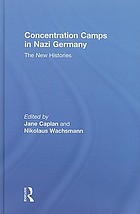

The website of Yad Vashem, the State of Israel's official memorial to victims of the Holocaust. Yad Vashem possesses the world's largest archive of materials relating to the Holocaust. Since 1963, Yad Vashem has also been responsible for recognizing and conferring honorary citizenship to the "Righteous Among the Nations," defined as non-Jews who risked their lives to save Jews during the Holocaust.
Editor's Note: Both antisemitism (hatred of Jewish people) and antisemitic violence had long histories that preceded the Holocaust and which have continued into the present day. The following resources provide historical background for the deeply-ingrained antisemitism that the Nazis exploited in order to scapegoat the Jews.
→ Further resources on anti-semitism can be found at the call number DS145.
 The Rise and Fall of the Third Reich : a history of Nazi Germany
by
The Rise and Fall of the Third Reich : a history of Nazi Germany
by
Editor's Note: Although the Nazi campaign against Jews was part of a long history of antisemitism in Europe, the rise of the Nazi party occurred within specific historical circumstances: the collapse of the German and Austro-Hungarian empires at the end of World War I, the reparations imposed by the Allied powers in the Treaty of Versailles, the rise of extremist groups in Germany during the period of the Weimar Republic, and the battles between ideological factions amid the crushing hardships of an economic Depression.
Editor's Note: Even before World War II had ended, historians and scholars have attempted to understand how millions of Germans were persuaded to go along with the Nazi program of murder and conquest; the following are some recent contributions to a much larger conversation.
Editor's Note: In the aftermath of Nazi annexation of Austria and Kristallnacht, many Jewish people in lands occupied by the Nazis sought to flee. The books in this box tell of organized efforts to rescue Jews such as the Kindertransport as well as strict immigration policies and untimely refusals to accept refugees that many argue cost innocent lives.
 Concentration Camps in Nazi Germany : the new histories
by
Concentration Camps in Nazi Germany : the new histories
by
This work is licensed under CC BY-NC-SA 4.0